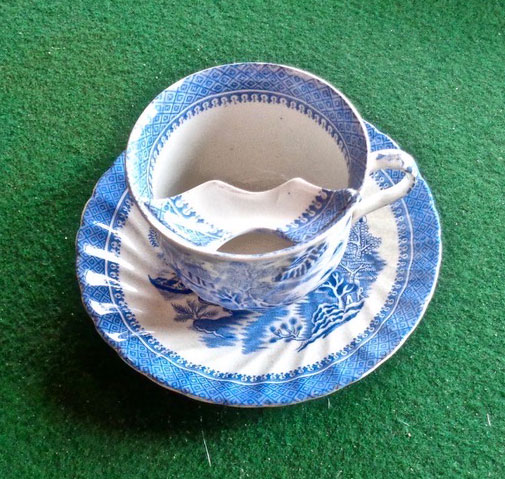When researching recently an heirloom from my grandmother, I was sidetracked, as I often am, into reading about other stuff. What caught my eye this time was an article by Dr Alun Withey about the history of Moustaches in Ireland, and I discovered that men sporting a soup strainer were persona non grata in 15th century Dublin. Even in sixteenth century Galway the council ruled that no one could be a citizen “unless he can speche the Englishe tonge and shave[s] his upper lipe wickly (weekly)”.
Why should the Anglo Norman ruling class not grow a ’tash? Moustaches were considered dangerous as they were worn by and associated with the local population who favoured a luxuriant long crommeal.
So if you sported a hairy lip you would be recognised as an Irish enemy of the colony. Englishmen who disobeyed the 1447 ban lost the protection of English law, identified as rebels and penalised for wearing any beard about the mouth or hair on the upper lip. (The French word mustache was not used in England until much later.) Indeed, colonists mistakenly killed other colonists because they were wearing moustaches in addition to the long Irish hairstyle, the culan, so it was important for Englishmen not to look Irish.
Meanwhile, across the water, beards and facial hair were PC. Medieval knights had their armour made to accommodate their beards, King James took the throne wearing a full set as did his son, while grandson Chas II jettisoned the beard but wore a moustache and voluminous wig. In Russia Peter the Great boosted his coffers by introducing a beard tax, bringing moustaches only back into fashion.
 The cup with a shelf was invented and patented by Harvey Adams in 1860 to provide a practical solution to the problem of gentlemen getting into hot water, literally, when face fungus was high fashion in Victorian times. So we have the Moustache Cup, now quite collectible, giving that they were only mass produced until around 1920. In literature perhaps the most famous was the sham Crown Derby one in James Joyce’s Ulysses when Leopold Bloom was given one by Milly his daughter for his birthday. They come in many shapes and sizes. Larger “farmers’ cups” hold as much as a pint, while dainty porcelain or silver pieces are sometimes embossed with the name of the owner.
The cup with a shelf was invented and patented by Harvey Adams in 1860 to provide a practical solution to the problem of gentlemen getting into hot water, literally, when face fungus was high fashion in Victorian times. So we have the Moustache Cup, now quite collectible, giving that they were only mass produced until around 1920. In literature perhaps the most famous was the sham Crown Derby one in James Joyce’s Ulysses when Leopold Bloom was given one by Milly his daughter for his birthday. They come in many shapes and sizes. Larger “farmers’ cups” hold as much as a pint, while dainty porcelain or silver pieces are sometimes embossed with the name of the owner.
So why the need? Well, it all started in India. A British Army Order, No. 1695, said that every soldier had to sport a hairy upper lip in order to impress the natives and to ensure their authority. The order said “The hair of the head will be kept short. The chin and the under lip will be shaved, but not the upper lip…” And so moustaches swiftly became the norm in the army and admired and copied at home.
Wax, mainly bear fat scented with lavender or sandalwood, was used to keep the hair stiff and in place. The only problem was that when the gentleman went to drink his tea or coffee the hot liquid melted the wax and it dripped into the beverage with the resulting awful taste, and, horrors of horrors in female company, the moustache wilted. One young lady was reported as saying that kissing a man who didn’t wax his moustache was like eating a boiled egg without salt!
During the First World War the army order was rescinded as whiskers made it difficult to don a gas mask successfully and it was also hard to maintain a decent level of grooming in the trenches. In addition, some of those very young recruits and volunteers hadn’t actually started to grow what Lord Dalhousie named “capillary decorations”. Consequently the moustache went out of fashion for the general public, although one other army issue, the Trench Coat, is still considered trendy.
Nowadays beards seem to be more popular and of course you can think of several famous men who sported different styles of lip trim - Salvador Dali, Clark Gable, and that irritating man in the Go Compare ad on TV. And of course, Hitler who progressed from the fashionably luxuriant Kaiserbart to a more restrained Toothbrush style, also favoured by Oliver Hardy and Fred Trump. The 2021 World Beard and Moustache championships, a biennial contest, will be hosted by the New Zealand Beard Club, with a special Whiskerina category for Ladies.
But back to the heirloom. These days you’ll find moustache cups and saucers in museums or private collections of Victoriana, or even if you go to the Dead Rabbit Bar in New York. There the manager sources antique examples from eBay and serves cocktails in them. Most of his customers don’t have moustaches but the shelf does an excellent job at saving you from a frozen lip by holding back the ice.
The set in the photograph is by Henry Alcock, made in the Elder (no relation) pottery at Cobridge and is what is called semi-porcelain, another name for ironstone, clay based. Used by my grandfather, who favoured a proliferent Chevron style whisker, the matching cup and saucer dates from around 1891, with Ching pattern decoration.
All for now, I moustache …
